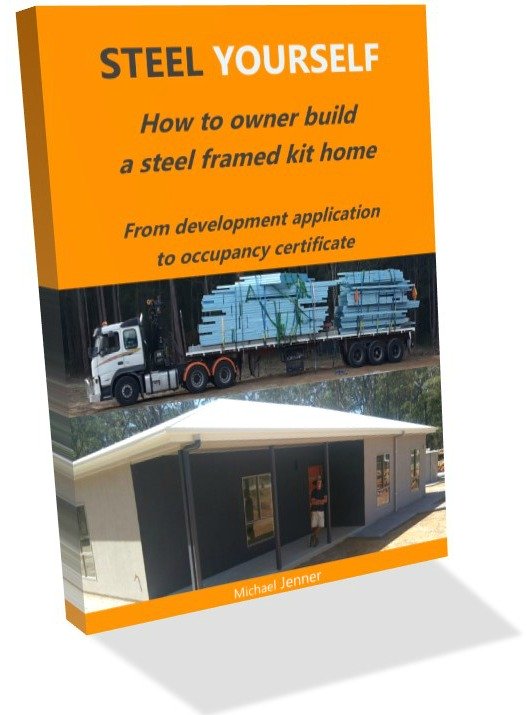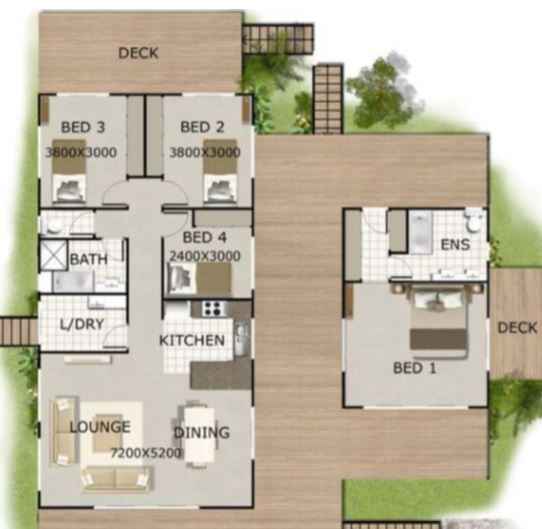Construction Terminology
for kit home owner builders
This construction terminology page provides a useful kit home glossary designed for the owner builder. Although not an exhaustive construction dictionary, it is kit home specific and caters for the novice owner builder learning the lingo.
The descriptive terms in this construction dictionary give meaning to building systems, methods, materials and tools to help you on your way to a great building experience.
Part 1:
A
Adjustable piers. Modern steel piers with threaded extendable spigots to alter the height of the pier.
Air-dried timber. Timber/lumber stored/seasoned to dry over time to make it true, usable and durable, preventing warping and bleeding. Also ‘kiln dried’, artificially dried, which is superior to air dried.
Anchor bolts. Used to secure building members mostly to foundations, eg frame anchors hold frame bottom plates to bearers or slabs.
Ant cap. Square or round galvanised plate turned down at 45 degrees and secured to the top of piers as a white ant shield or deterrent.
Architrave. Also ‘cover mould’ or door/window lining, moulding surrounding a door or window-opening to cover the joint between the window reveal and the wall finish.
B
Backfill. Using excess excavated earth to fill trenches or against a foundation.
Balustrade. A usually decorative safety railing using a top and bottom rail, upright members (balusters) for edges of stairs and verandahs/decks.
Bar chair. A formed wire or plastic stirrup to suspend reinforcing mesh inside poured concrete slabs.
Barge board. A decorative board covering the ends of rafters at the gable end.
Battens. Narrow strips of wood or moulded steel screwed to the top chord of trusses to secure roofing iron or tiles or screwed to the underside of the bottom chord of trusses or ceiling joists to attach plasterboard/drywall to create a ceiling.
Batter boards. Horizontal boards nailed to posts, set at the corners of an excavation, used for the initial setout of a house plan for checking levels and squares of foundations.
Beam or bearer. Usually the largest column of timber or steel used as the base support of a floor system. Sometimes called a girder.
Boning rod. A measuring rod in the shape of a cross to determine the depth of pier holes.
Bull float. Large flat finishing screeder with a long handle to finish large sections of wet concrete slab.
Butt joint. A simple unworked joint between two pieces of timber. Usually needs gang nailing to secure.
Bracing. Can be used in multiple areas to resist diagonal and wind force: across wall frames and trusses, temporary support of wall frames during construction. Can be timber, steel speed bracing or plywall bracing. See also 'bridging'.
Brick veneer. Type of construction where brick walls are used to clad a timber framed house.
Bridging. Small wood or metal sections nailed between floor joists in a floor system, usually at the ends and mid sections to brace and tension and to prevent twisting. Sometimes called ‘cross’ bridging.
C
Cabin. Small one or two room dwelling.
Cornice. Decorative moulding of plasterboard or wood mitered around the join between the wallboard and the ceiling.
Crawl space. An area between the ground and a low floor system enclosed by a foundation wall or timber skirting.
D
Dado wall. A one metre vertical tongue and groove timber section of interior wall commonly used as protection from lounge chairs modern times just for decoration.
Damp-proof course. A barrier just above ground level at the base of the wall to prevent rising damp
Door furniture. Metal accessories for a door, including hinges, handles, locks, bolts, latches and strikers
Doorjamb. The upright and top surrounding moulded timber of a door to open from or close into. Also called side jambs and head jambs.
Drywall. Also plasterboard, wall board, gyprock, large sheets used to cover interior frames and ceiling trusses.
E
Eaves. Also soffits, fibrous cement sheeting or planking used to cover the underside of the truss overhang.
Expansion joint. A strip of heavy rubber or bituminous fiber used between slabs of concrete to prevent cracking.
F
Fascia. A flat board or moulded strip of metal attached to gable or truss ends commonly with fascia brackets to which gutters are sometimes attached.
Fibreboard. Also ‘fibre cement’, ‘fibro’, used as cheap panel siding or soffits, ceilings and attics.
Flashing. Sheet metal, sometimes lead based, or rubber used in roof, wall and window construction to protect a building from water entering.
Flat pack. Refers to pre-manufactured carcases, doors, kick panels and benchtops of kitchen units delivered ready to assemble.
Floor sheeting. Structural particle board with pvc tongue and groove edging. It has a resin enriched surface and can be pest treated.
Footing. A concrete section, poured in a deep hole in a rectangular form to provide a foundation for a wall or pier.
Foundation. A concrete slab or long supporting concrete portion of a structure below the first floor including the footings.
Frame construction. Also called 'stick built', where the structural parts of the house are stud wood frames and trusses.
G
Gable. The end portion of the roof, usually triangular in shape above the eave line of a double-sloped roof.
Gang nail. Manufactured galvanized plate of nails used to secured two or three timber butt joins such as in trusses.
Grout. Fine viscous sometimes coloured mortar designed to fall into tile spacings, joints to help secure and waterproof and decorate.
Gutter system. Modern prefabricated components: fascia brackets, fascia, suspension clips, gutter straps, downpipes and formed gutter, to transport roof water away from the house.
H
Hardwood. Close-grained, heavy wood used for its strength and durability, more difficult to cut, shape and nail than soft wood.
Heel. The end of a rafter or base of a truss that rests on/over the wall plate of a frame.
Hip roof. A roof that rises by from all four sides of a building.
I
I-beam. Also 'RSJ', a large steel beam with a cross section resembling the capital letter ‘I’, used for long spans, basement beams, lintels or over wide wall openings with high loads.
Insulation. Material that will reduce the rate of heat or cold flow or transmission.
J
Jamb. See ‘Door jamb’
Joists. Large parallel beams, usually placed on bearers to support floors. Also used to support ceiling loads.
Joist hanger. Formed galvanized stirrup designed to be nailed to a bearer plate to support a joist at its butt end.
K
Kit home. A home constructed using pre-fabricated components.
L
Landing. A platform at the end or between flights of stairs.
Lattice. A decorative manufactured framework of crossed wood or metal strips.
Lintel. The support beam above a window, door or other opening.
Log cabin/home. Dwelling constructed from formed logs interlinking at the external corners. Commonly post and beam structure.
M
Masonry. Walls built using brick, stone, tile or similar materials.
Miter joint. The joint of two pieces of timber, made by sawing and or chiseling part of the surface to enable a solid glue-able join.
Moisture Barrier. Treated paper or metal that retards or bars water vapor, used to keep moisture from passing into walls or floors.
Moulding. A wood strip profiled in a timber mill to have a projecting surface used for decorative purposes.
Contruction terminology Part 2
N
Noggin. Horizontal wood bracing member between studs in wall frames.
O
Owner builder. The situation where a person who is not a registered builder can be licensed to build or facilitate the building of their own home.
P
Panelized home. A house constructed using prefabricated or panelized walls, ie walls which include cladding, sarking, insulation, frames and internal wall boards.
Pitch. The incline or slope of a roof or the ratio of the total rise to the total width of a house.
Plasterboard (also see Dry Wall), Gypsum board, used instead of plaster.
Plate. Top horizontal member of a frame wall supporting ceiling joists, rafters, or other members.
Plate tie. Galvanized strap for securing frame top and bottom plates to studs.
Post-And-Beam Construction.Wall construction in which beams are supported by heavy posts and long beams, rather than many smaller studs.
Power trowel. Also ‘power float’, a motorized trowling machine used to finish large sections of newly poured slabs.
Prefabrication. Construction of components such as frames, complete walls, trusses or 'pre-hung' doors before delivery to the building site.
Pre-hung doors. Pre-manufactured and assembled door jambs with doors installed.
Plumb. To make exactly perpendicular, vertical or central.
Q
Quarter round. Also Quad, a small moulding that has the cross section of a quarter circle.
R
Rafters. A series of sloping structural members of a roof designed to support roof loads.
Raised floor system. A floor generally on piers, bearers and joists.
Reinforcing. Steel rods (reo) tied into the centre of concrete slabs, beams, or columns to increase their strength.
Rough in. A term used in plumbing and electrical installation: the initial base level work done by the contractor before slabs are laid or walls are completed.
S
Sarking (sarking membrane): Pliable, water-resistant membrane located beneath the roof covering or external wall cladding to collect and discharge water that may penetrate.
Screed/screeding. A strip of wood or metal with a handle, used as a finishing guide for plastering or concreting.
Seasoning. Drying/removing moisture from green/new wood in order to reduce shrinkage and warping.
Setting out. Using batter boards, string-lines and levels to determine the exact place a foundation will be constructed.
Shiplap. Timber siding that is edge-dressed to make a close rebated or lapped joint for weatherproofing and appearance.
Siding. Wood framed house cladding material to finish the outside wall, can be weatherboards, vertical boards with battens, shingles, fibre cement.
Skirtings. Narrow boards sometimes profiled around the margin of a floor.
Slab. Usually reinforced concrete floor placed directly on earth or a gravel base.
Soil test. Part of a site survey to investigate the structure and reactivity of the ground around and under intended foundations areas.
Span. The distance between structural supports such as walls, columns, piers, beams, girders, and trusses.
Speedbrace. Heavy galvanised strap used to brace multiple trusses together and down to top plates. Also used to diagonally brace wall frames.
Steel home kit. Pre-manufactured kit home with components comprising steel frames and trusses.
Stringer. In stairs, the support on which the stair treads rest; also stringboard.
Stucco. Commonly refers to an outside plaster made with Portland cement as its base.
Stud. One of a series of wood or metal vertical structural members placed as supports in wall frames and partitions.
T
Termite shield. A shield, usually of non-corroding metal, placed in or on a foundation wall or other mass of masonry or around pipes to prevent passage of termites.
Timber stops. Also ‘corner boards’, attached vertically down the external corners of buildings as trim to push the ends of the siding against.
Theodolite. A laser leveling instrument commonly used to establish correct depth of foundations, levels of excavations, and slab formwork.
Tread. Horizontal board in a stairway on which the foot is placed.
Trim. The finishing materials in a building, such as mouldings applied around openings (window trim, door trim) or at the floor and ceiling of rooms (baseboard, cornice, and other mouldings)
Truss. A combination of structural members usually arranged in triangular units to form a rigid framework for spanning between load-bearing walls.
V
Valley. The internal angle formed by the junction of two sloping sides of a roof.
Vibrator. A hand operated motorized rod used in concreting which is inserted into wet concrete to remove air pockets and help concrete bond with reinforcing.
Vapor barrier. Also 'house wrap' and ‘sarking’, material used to restrict the movement of water vapor into walls and prevent condensation in them.
W
Weatherstrip. Narrow sections of thin metal, rubber or other material to prevent infiltration of air and moisture around windows and doors.
Wet seal. Fibreglass waterproofing membrane applied to shower bases and walls.
Y
Yurt. Circular tent with wooden internal structure commonly moveable.




